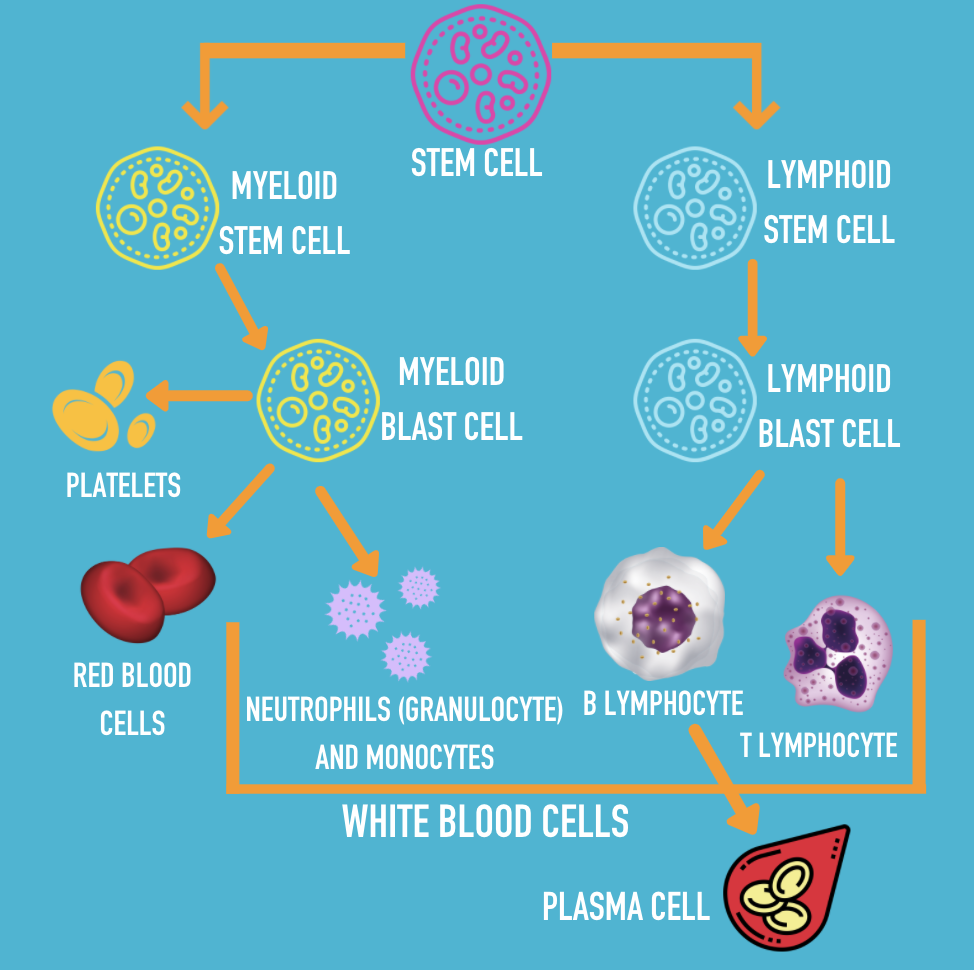BLOOD CANCER
THE BONE MARROW
Blood cancer is typically caused by a problem in the bone marrow, and in some types of blood cancer, it can also affect the lymphatic system. The bone marrow is the soft, spongy tissue that is found in the centre of bones throughout the body. It is the bone marrow that is responsible for the production of stem cells, which have the ability to mature into many different types of cells, including red blood cells, white blood cells, and platelets. The image below shows how your blood cells are produced in the bone marrow:
Blood cancer can be caused due to a fault at the level of the bone marrow. When the production of stem cells becomes unregulated, abnormal blood cells are produced, and when abnormal cells build up in the blood and bone marrow, they do not function like healthy cells. As these cells fill up the space in your bone marrow, your body does not have space to make the healthy white blood cells, red blood cells, and platelets it needs to function properly. Therefore, it is the unregulated production of these abnormal cells that can cause certain blood cancers.
THE LYMPHATIC SYSTEM
The lymphatic system is made up of vessels and lymph nodes that run throughout the body. This system carries a fluid called 'lymph', which is essential in protecting us against infections and diseases that enter our bodies. Important components of the lymphatic system include the bone marrow, lymph nodes, tonsils, thymus, liver, and spleen.
Blood cells from the lymphoid lineage (as shown in the image above) can become cancerous in the lymphatic system. These cancerous cells can build up in the lymphatic system, causing different types of blood cancer to develop. As the lymphatic system runs throughout the body, cancer can develop anywhere. Therefore, there are many different types of blood cancer that can cause a variety of symptoms. The production of white blood cells is also affected, meaning the body cannot fight or prevent infections as effectively, leaving patients susceptible to developing and suffering from infections.
There are more than 100 different types of blood cancer, which can be classified into three main groups:
LEUKAEMIA
Leukaemia is the most common type of cancer found in children and teenagers. This group of blood cancers usually begin in the bone marrow, where red blood cells, white blood cells, and platelets are produced. People with leukaemia produce high numbers of abnormal blood cells and low numbers of healthy blood cells, reducing the important effects of these cells throughout the body. Because of this, leukaemia can cause a range of different symptoms.
LYMPHOMA
Lymphoma is known as the cancer of the lymphatic system. The lymphatic system is made up of lymph nodes, vessels, and organs that run throughout the body, which are important in protecting us against diseases and infections. As the lymphatic system runs throughout your body, lymphoma can start anywhere. Because of this, people living with lymphoma can experience a range of symptoms, some of which may require blood transfusions to manage.
MYELOMA
Myeloma (also known as multiple myeloma) is a type of blood cancer that develops in the bone marrow, in plasma cells. Plasma cells are important in creating antibodies, which are essential in helping our bodies fight against infections. Every year, 5,800 people are diagnosed with myeloma in the UK. That is 16 people every day.




